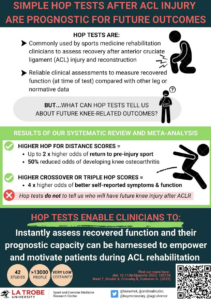Keywords: Rehabilitation, Anterior cruciate ligament, Hop test
We recently published our systematic review in BJSM investigating the prognostic capacity of unilateral tests of lower-limb function following anterior cruciate ligament (ACL) injury and reconstruction (ACLR).1 The summary of this study is outlined in this blog.
Why is this study important?
Functional or physical performance tests, such as hop tests, are commonly used to assess recovery after anterior cruciate ligament (ACL) injury and reconstruction. Hop tests are quick and easy to administer, typically requiring only a tape measure and stopwatch. They are often performed as part of a test battery to determine rehabilitation progression and when an athlete can safely return to sport.5 Performance on these tests also provides prognostic value for future knee-related outcomes6 7 but until now data on the prognostic capacity of hop tests has not been synthesised systematically.
How did the study go about this?
We conducted a systematic review following Preferred Reporting Items for Systematic Reviews and Meta-Analyses (PRISMA) guidelines. Included studies reported associations between hop tests (expressed as a limb symmetry index [LSI=index limb ÷ contralateral limb x 100) following ACL injury and future (≥3 months) knee-related outcomes. Meta-analyses was conducted to synthesise the data, combining results from studies reporting on the same hop test and association with the same outcomes. We also assessed whether test batteries, incorporating hop tests together with strength measures, were associated with future knee-related outcomes.
What did the study find?
We included 42 studies (13,150 adolescents and adults, 44% female) that assessed either the single-forward hop or a repeated-forward hop (e.g., crossover, triple, 6m-timed hop, all analysed together).
Our meta-analyses indicated that better performance on single-forward hop and repeated-forward hop tests was associated with:
- Twice the odds of return to pre-injury sport up to 3 years post-ACLR
- 2-4-fold the odds of better self-reported-symptoms and function up to 15 years post-ACLR
- 50% reduced odds of radiographic osteoarthritis 5-37 years post-ACLR (in relation to achieving ≥90% LSI single-forward hop test only)
Hop test performance was not related to success for an ACL-deficient knee (i.e., not having surgery after injury) or with avoiding future injury.
For test batteries incorporating hop tests together with strength and biomechanical measures:
- Achieving ≥90% LSI on all criteria is associated with increased likelihood of returning to sport
- Achieving ≥90% LSI on all criteria is not associated with avoiding subsequent knee injury
Our results need to be interpreted with caution as they are associated with very low certainty evidence; 65% of included studies had high risk of bias.
Key clinical take homes:
- Hop tests can inform clinicians and patients of potential future outcomes after ACL injury and reconstruction.
- Our results encourage the continued use of hop tests during ACL rehabilitation and as part of return to sport testing, though best-available evidence suggests that achieving adequate performance does not automatically reduce subsequent knee injury risk.
- The prognostic capacity of individual hop tests and hop test batteries should be harnessed by clinicians to empower and motivate patients along their ACL rehabilitation journey. They provide instant feedback and their important impact on future outcomes can be utilised to enhance motivation and adherence to rehabilitation.

References
- West TJ, Bruder AM, Crossley KM, et al. Unilateral tests of lower-limb function as prognostic indicators of future knee-related outcomes following anterior cruciate ligament injury: a systematic review and meta-analysis of 13 150 adolescents and adults. British Journal of Sports Medicine 2023:bjsports-2022-105736. doi: 10.1136/bjsports-2022-105736
- Grindem H, Snyder-Mackler L, Moksnes H, et al. Simple decision rules can reduce reinjury risk by 84% after ACL reconstruction: the Delaware-Oslo ACL cohort study. Br J Sports Med 2016;50(13):804. doi: 10.1136/bjsports-2016-096031
- Ardern CL, Taylor NF, Feller JA, et al. Sports participation 2 years after anterior cruciate ligament reconstruction in athletes who had not returned to sport at 1 year: a prospective follow-up of physical function and psychological factors in 122 athletes. Am J Sports Med 2015;43(4):848-56. doi: 10.1177/0363546514563282 [published Online First: 2015/01/15]
- Davies WT, Myer GD, Read PJ. Is It Time We Better Understood the Tests We are Using for Return to Sport Decision Making Following ACL Reconstruction? A Critical Review of the Hop Tests. Sports Med 2020;50(3):485-95. doi: 10.1007/s40279-019-01221-7
- van Melick N, van Cingel RE, Brooijmans F, et al. Evidence-based clinical practice update: practice guidelines for anterior cruciate ligament rehabilitation based on a systematic review and multidisciplinary consensus. Br J Sports Med 2016;50(24):1506-15. doi: 10.1136/bjsports-2015-095898 [published Online First: 2016/08/20]
- Logerstedt D, Grindem H, Lynch A, et al. Single-legged hop tests as predictors of self-reported knee function after anterior cruciate ligament reconstruction: the Delaware-Oslo ACL cohort study. Am J Sports Med 2012;40(10):2348-56. doi: 10.1177/0363546512457551 [published Online First: 2012/08/29]
- Wellsandt E, Axe MJ, Snyder-Mackler L. Poor Performance on Single-Legged Hop Tests Associated With Development of Posttraumatic Knee Osteoarthritis After Anterior Cruciate Ligament Injury. Orthop J Sports Med 2018;6(11):2325967118810775. doi: 10.1177/2325967118810775 [published Online First: 2018/12/07]
Author and Affiliations:
Thomas West 1,2, Dr Andrea Bruder 1,2, Professor Kay Crossley 1,2, Dr Adam Culvenor 1,2
1 – La Trobe Sport and Exercise Medicine Research Centre, School of Allied Health, La Trobe University, Bundoora, Victoria, Australia
2 – Australian IOC Research Centre, La Trobe University, Bundoora, Victoria, Australia
Twitter: @tsewmot @AndreaBruder @Agculvenor @kaymcrossley